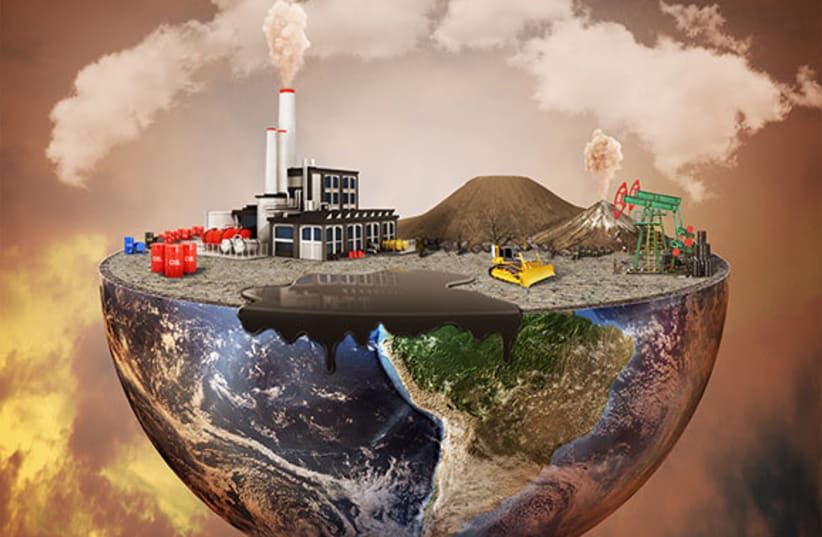The Environmental Protection Ministry released its first set of national climate risk maps on Monday to help decision-makers, security forces, and the general public better understand and prepare for the impacts of climate change.
The online maps include information on physical threats such as floods, urban heat loads, and extreme sea levels.
Specifically, they are meant to help decision-makers better understand the likelihood of being exposed to certain risks and who and what is vulnerable to that risk due to socioeconomic, age, or other factors. Ultimately, the ministry hopes the maps can help streamline decision-making on climate change adaptation across all sectors and levels.
"Accessible and reliable information on exposure, sensitivity, and adaptive capacity to local climate change is crucial for optimizing decision-making and implementing data-driven approaches," said Prof. Noga Kronfeld-Schor, the Environmental Protection Ministry's chief scientist, who led the project. "These maps will assist in decision-making and setting priorities based on science and knowledge.
"The maps and other tools available on the website will continue to be updated and improved over time, contributing to the enhancement of Israel's climate resilience."


Environmental Protection Minister Idit Silman said that this new tool further shifts her ministry from one focused almost entirely on regulation to one that will directly assist and impact citizens via their local municipalities. She said the national climate risk maps are a major "breakthrough" for her team, which did not take an off-the-shelf product and adapt it but developed the tool independently.
Recent trends and the effects of the war necessitate an uptick in public awareness
In recent years, Israel, like much of the rest of the world, has been experiencing an increase in the frequency and severity of extreme weather events, including floods and heat waves. This trend is expected to intensify alongside desertification, rising sea levels, and other environmental challenges.
Moreover, environmental scientists and activists have accused the Israeli government of not taking the necessary steps to fight the climate change crisis, which they have said could lead to dire consequences for the country in the future.
"Especially in these days of the Swords of Iron war, there is an importance for security forces, local authorities, and the public to receive accurate information related to physical threats, such as floods and heatwaves, to prepare efficiently," the ministry said.
Although the tool is only in its first stage, the ministry decided to publish this version "due to the high importance of this information at present."
The first version, released on Monday, focuses on mapping the current climate impacts at a high spatial resolution (without future projections). It presents several geographic data layers as examples, including information on exposure, sensitivity, and adaptive capacity to climate change. Additionally, it introduces a primary index that reflects the vulnerability of the elderly population to climate change, integrating these three dimensions.
Kronfeld-Schor worked on the project with other professional staff from her ministry and coordinated with a broad inter-ministerial committee. A panel of more than 125 experts in economics, health, the environment, and infrastructure are working on the tool.
Specifically, the national climate risk maps include high-resolution spatial maps of physical threats. The main threats highlighted by the government's management for climate change adaptation include increased frequency and severity of floods, urban heat loads, wildfires, and rising sea levels.
Later versions will incorporate maps of future scenarios based on projections from the Intergovernmental Panel on Climate Change (IPCC).
Among the exposure layers is the flood layer, so local authorities and security forces can better prepare for possible floods, Kronfeld-Schor explained. The flooding scenarios presented on the maps are based on meteorological, climatic, hydraulic, and hydrological models developed by Tomorrow.io. The scenarios presented represent events with a 2% probability, equivalent to a once-in-50-year event.
The flood scenarios are divided into three types: Floods from streams and drainage basins (inundation maps), floods resulting from urban topography, and extreme sea levels causing coastal flooding.
The urban heat islands layer focuses on areas where human-made materials in urban environments absorb and retain more heat than natural surfaces. This layer helps identify areas where higher temperatures are expected.
The vulnerability layers focus on individuals above 70, known to be vulnerable to climate change. Vulnerability is measured based on population density above the age of 70 in various regions.
Adaptation-capacity layers are designed based on the assumption that residents in low socioeconomic areas have the lowest adaptation capacity.
Kronfeld-Schor said that the team recognizes that these maps have their set of challenges, including the current shortage of data to feed them. She said there remains a high level of uncertainty even in short-term predictions. However, she noted that the ministry decided to roll the tool out anyway because "we need to prepare now."
She said that the ministry adopted an approach of "the data is good enough" and that decision-makers should consider uncertainty when using the tool.
The maps are expected to improve and be updated over time, Kronfeld-Schor said.
The Environment and Climate Change portal is produced in cooperation with the Goldman Sonnenfeldt School of Sustainability and Climate Change at Ben-Gurion University of the Negev. The Jerusalem Post maintains all editorial decisions related to the content.
